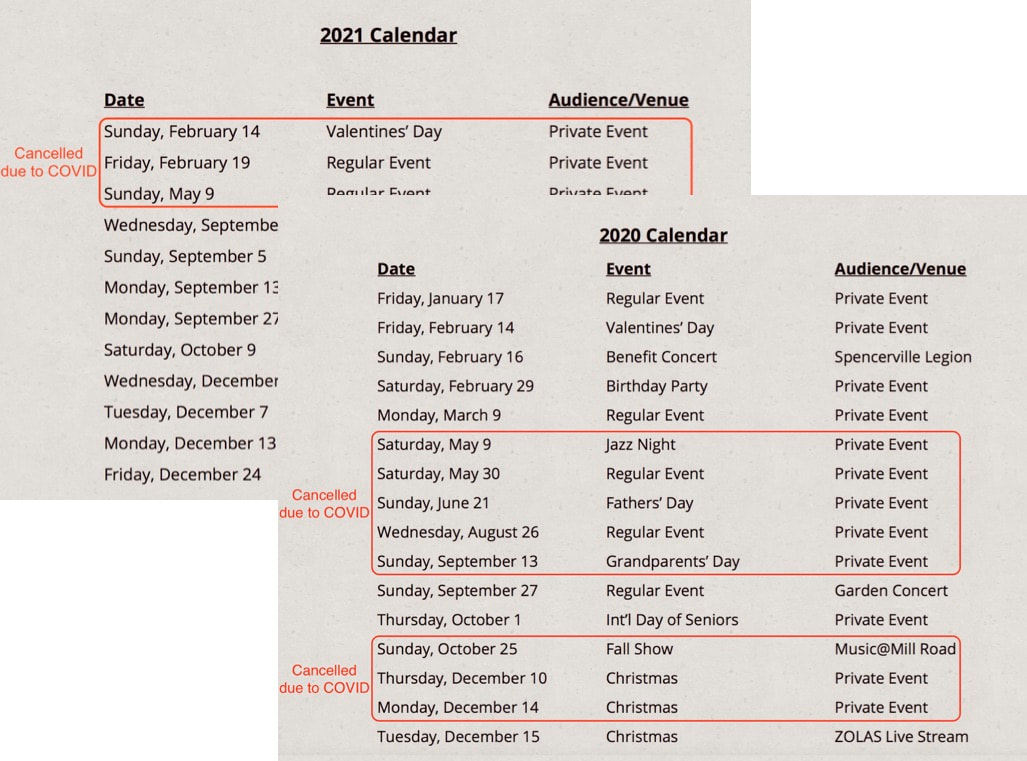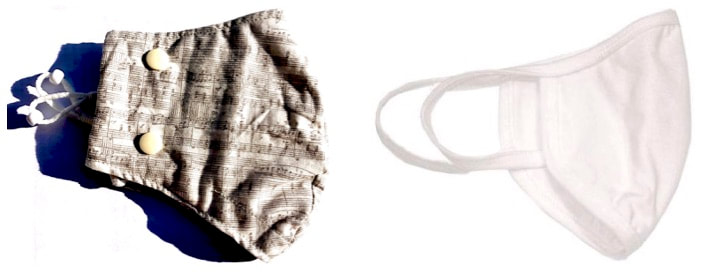Singing Through COVID
Author: John Wilson
[email protected]
Date: November 17, 2021
Disclaimer: The opinions expressed in this article are those of the author and are not necessarily those of Ottawa Jazz Happenings or of JazzWorks Canada.
Overview
This article is about the masking experiences of Cuppa Joe, from the a cappella quartet’s performances through the height of COVID to the relaxation of lockdowns and other constraints in the latter part of 2021.
Unlike most jazz bands, which typically comprise a mix of instrumentalists or a band-backed vocalist, Cuppa Joe relies exclusively on band members’ voices. The masking of singers and the resulting breathing issues and changes to the sound produced are more of an issue than the masking of non-wind instrumentalists, such as pianists, percussionists and bass players.
It’s beyond the scope of this article to probe the complex issues of masking (or other treatment of) wind instrument players such as brass (trumpet, trombone, etc.) and woodwind (saxophone, clarinet, flute, etc.) instrumentalists.
This article is about the masking experiences of Cuppa Joe, from the a cappella quartet’s performances through the height of COVID to the relaxation of lockdowns and other constraints in the latter part of 2021.
Unlike most jazz bands, which typically comprise a mix of instrumentalists or a band-backed vocalist, Cuppa Joe relies exclusively on band members’ voices. The masking of singers and the resulting breathing issues and changes to the sound produced are more of an issue than the masking of non-wind instrumentalists, such as pianists, percussionists and bass players.
It’s beyond the scope of this article to probe the complex issues of masking (or other treatment of) wind instrument players such as brass (trumpet, trombone, etc.) and woodwind (saxophone, clarinet, flute, etc.) instrumentalists.
Getting to Here
The earlier article “Cuppa Joe: Weathering COVID Musically” described our situation for the first COVID year ending in February 2021. It covered rehearsing, gigging, and lockdown activities such as music videos, etc. This article is about masking specifically, particularly since indoor performing again became possible in the fall of 2021.
Our gig plans for 2021 somewhat mimicked those for 2020, with lots of COVID cancellations (see Image 1).
The earlier article “Cuppa Joe: Weathering COVID Musically” described our situation for the first COVID year ending in February 2021. It covered rehearsing, gigging, and lockdown activities such as music videos, etc. This article is about masking specifically, particularly since indoor performing again became possible in the fall of 2021.
Our gig plans for 2021 somewhat mimicked those for 2020, with lots of COVID cancellations (see Image 1).
Image 1 — 2020-21 Performance Calendars
Only one indoor gig was feasible for us prior to this fall, due both to restrictions and our own comfort level in ‘sharing the air’ with large groups. That gig was at a retirement home in October 2020 — well before vaccinations were available — and we simply wore masks of our own choosing (see Image 2). There were no other requirements in place at that time other than the COVID questionnaire and the need for masks for both performers and audience.
Image 2 — Masked in 2020
Gig Planning for 2021-2022
From the outset of 2021, we decided to focus on private gigs rather than public ones. This way, we would be in COVID-controlled situations with audiences who were comfortable with attending concerts. And on the flip side, we didn’t risk a lot of work for a public show only to find people too uncertain about COVID and COVID-control mechanisms to attend!
From the outset of 2021, we decided to focus on private gigs rather than public ones. This way, we would be in COVID-controlled situations with audiences who were comfortable with attending concerts. And on the flip side, we didn’t risk a lot of work for a public show only to find people too uncertain about COVID and COVID-control mechanisms to attend!
Masking for the Fall (2021)
We’d had the brief experience of masking for that one indoor event in October 2020. We even had masks made for us (an example is shown in Image 3), thinking that we’d be using them a fair bit. Then, fast-forward to September 2021, when we had an indoor gig booked for every week (!), and the COVID performance requirements had changed.
We experienced a mix of mask usage, depending on each venue’s specific requirements, from using our own cloth masks, to wearing one-time medical masks issued by the venue, to singing without masks behind a large plastic sheet. Each of these presented its own challenges, of course.
We’d had the brief experience of masking for that one indoor event in October 2020. We even had masks made for us (an example is shown in Image 3), thinking that we’d be using them a fair bit. Then, fast-forward to September 2021, when we had an indoor gig booked for every week (!), and the COVID performance requirements had changed.
We experienced a mix of mask usage, depending on each venue’s specific requirements, from using our own cloth masks, to wearing one-time medical masks issued by the venue, to singing without masks behind a large plastic sheet. Each of these presented its own challenges, of course.
Image 3 — Cloth Masks
left: 'designer' mask; right: common white cotton mask
left: 'designer' mask; right: common white cotton mask
Cloth Masks
We found that cloth masks were the worst option, especially the common white ones found in large quantities, since they tend to trap heat. They also have no real ‘structure’ to them so are drawn into the mouth with intakes of breath (see Image 3). The white cotton masks have another key drawback: they don’t have enough vertical flexibility, so the mask moves up and down dramatically when singing, often slipping down, or off the chin. Also, they tend to fog up eyeglasses and to muffle vocal sound more than other
masks that we tried out.
Medical Masks
Most venues we booked for the current year (2021) have required us to use their masks, which are the standard medical (level 3) single-use ones (see Image 4). Personally, I find they have a slightly unpleasant odour to them. However, they function fairly well while singing, and provide a long, flexible vertical component that does a better job of keeping them in place while breathing in, than with cloth masks.
We found that cloth masks were the worst option, especially the common white ones found in large quantities, since they tend to trap heat. They also have no real ‘structure’ to them so are drawn into the mouth with intakes of breath (see Image 3). The white cotton masks have another key drawback: they don’t have enough vertical flexibility, so the mask moves up and down dramatically when singing, often slipping down, or off the chin. Also, they tend to fog up eyeglasses and to muffle vocal sound more than other
masks that we tried out.
Medical Masks
Most venues we booked for the current year (2021) have required us to use their masks, which are the standard medical (level 3) single-use ones (see Image 4). Personally, I find they have a slightly unpleasant odour to them. However, they function fairly well while singing, and provide a long, flexible vertical component that does a better job of keeping them in place while breathing in, than with cloth masks.
Image 4 — Medical Masks Issued at Our Gigs
(K)N95 Masks
There are different varieties of this medical mask, especially the better-known N95 and KN95. But we didn’t feel the need to advance to this level for our purposes. So we have no comparative information about this category of mask.
Would they provide better protection? Almost certainly. But, in this period of performing, we are primarily singing in an environment where 1) everyone is doubly-vaccinated, 2) there is a sizeable space between performers and audience, 3) we and the audience are generally masked, and 4) the four of us are very COVID-aware and careful, and we are like an extended family to one another.
Mask Inserts
Some (vocal) band members still found too much inward movement with the intake of breath, even with medical masks. To address that, we’ve tried both plastic inserts and soft silicone inserts that fit over the mouth area to shape the mask and keep it from getting close to the mouth (see Image 5). We found the harder plastic ones uncomfortable, whereas the silicone ones work well and are already used by some band members. Other advantages of inserts is that they keep the mask from slipping down, are reusable, and can work with the masks that are typically issued to us at gig venues. Image 6 shows how the silicone insert fits into a medical mask.
There are different varieties of this medical mask, especially the better-known N95 and KN95. But we didn’t feel the need to advance to this level for our purposes. So we have no comparative information about this category of mask.
Would they provide better protection? Almost certainly. But, in this period of performing, we are primarily singing in an environment where 1) everyone is doubly-vaccinated, 2) there is a sizeable space between performers and audience, 3) we and the audience are generally masked, and 4) the four of us are very COVID-aware and careful, and we are like an extended family to one another.
Mask Inserts
Some (vocal) band members still found too much inward movement with the intake of breath, even with medical masks. To address that, we’ve tried both plastic inserts and soft silicone inserts that fit over the mouth area to shape the mask and keep it from getting close to the mouth (see Image 5). We found the harder plastic ones uncomfortable, whereas the silicone ones work well and are already used by some band members. Other advantages of inserts is that they keep the mask from slipping down, are reusable, and can work with the masks that are typically issued to us at gig venues. Image 6 shows how the silicone insert fits into a medical mask.
Image 5 — Mask Inserts
left: hard plastic insert; right: soft silicone insert
left: hard plastic insert; right: soft silicone insert
Image 6 — Medical Mask with Silicone Insert
Plastic Barrier
We were fortunate with one venue that has a large stage and implemented a ceiling-hung plastic screen across the entire stage, stretching almost to the stage floor (see Image 7). While it did slightly ‘mask’ the audience visuals, it made for the best sound from the band, since we didn’t need to wear face masks and the speakers were placed outside the barrier. This made it the most comfortable of the COVID-era performing experiences for all.
We were fortunate with one venue that has a large stage and implemented a ceiling-hung plastic screen across the entire stage, stretching almost to the stage floor (see Image 7). While it did slightly ‘mask’ the audience visuals, it made for the best sound from the band, since we didn’t need to wear face masks and the speakers were placed outside the barrier. This made it the most comfortable of the COVID-era performing experiences for all.
Image 7 — Venue with Stage and Plastic Barrier
The Future (Or, at Least, 2022)
How will things work in the near and far future? Who knows? Cuppa Joe continues to move forward, ready to pivot again if need be. After all, this is both for our own creative output and the ability to bring our music to others who enjoy it.
We’ve started to take bookings for next year (see Image 8) and continue to plan for a future of regular performance. When will we next see a public performance from Cuppa Joe? We’ve certainly discussed this within the quartet from time to time, as we continue to closely monitor public health guidelines. At the time of this writing, we are discussing a possible Christmas show, and are considering options for a spring show in 2022.
How will things work in the near and far future? Who knows? Cuppa Joe continues to move forward, ready to pivot again if need be. After all, this is both for our own creative output and the ability to bring our music to others who enjoy it.
We’ve started to take bookings for next year (see Image 8) and continue to plan for a future of regular performance. When will we next see a public performance from Cuppa Joe? We’ve certainly discussed this within the quartet from time to time, as we continue to closely monitor public health guidelines. At the time of this writing, we are discussing a possible Christmas show, and are considering options for a spring show in 2022.
Image 8 — 2022 Bookings to Date
Conclusions
It’s been a couple of years of constant change. Although several gigs were cancelled along the way due to COVID restrictions, we found other musical activities to keep us interested, creative and active as a group. For example, we produced two music videos — one for ourselves and one for a client — and we continued to develop and increase our repertoire.
We’ve tried — and been exposed to — a number of tools and techniques to manage the COVID risks. Each brings its own benefits and challenges. But we love to get our music out there, so the additional time and effort are worth it.
Some venues require performers to wear the masks they issue; but you can find ways to make them work for you, such as the silicone inserts used by some of us.
We look forward to the day when masks are no longer required. It will make singing a lot more comfortable, the sound better for the audience, and we’ll better ‘feel’ the music and stage moves that characterize our performances.
It’s been a couple of years of constant change. Although several gigs were cancelled along the way due to COVID restrictions, we found other musical activities to keep us interested, creative and active as a group. For example, we produced two music videos — one for ourselves and one for a client — and we continued to develop and increase our repertoire.
We’ve tried — and been exposed to — a number of tools and techniques to manage the COVID risks. Each brings its own benefits and challenges. But we love to get our music out there, so the additional time and effort are worth it.
Some venues require performers to wear the masks they issue; but you can find ways to make them work for you, such as the silicone inserts used by some of us.
We look forward to the day when masks are no longer required. It will make singing a lot more comfortable, the sound better for the audience, and we’ll better ‘feel’ the music and stage moves that characterize our performances.
Acknowledgements
Many thanks to my wife, Linda Wilson, for her usual fine editing, and for her many creative ideas for the presentation of the elements in this article.
I really appreciate the feedback on early drafts from my band members — Cathy Thompson, Mary Moore and Peter Feldman — each of whom contributed ideas worth explaining more fully or grammatical improvement to the article.
As usual, Chris Thompsons’ insightful feedback caused me to think more deeply in several areas and to provide additional information about our experiences. And, yes, I also appreciate his ‘style guide’ (notice the single quotes).
Many thanks to my wife, Linda Wilson, for her usual fine editing, and for her many creative ideas for the presentation of the elements in this article.
I really appreciate the feedback on early drafts from my band members — Cathy Thompson, Mary Moore and Peter Feldman — each of whom contributed ideas worth explaining more fully or grammatical improvement to the article.
As usual, Chris Thompsons’ insightful feedback caused me to think more deeply in several areas and to provide additional information about our experiences. And, yes, I also appreciate his ‘style guide’ (notice the single quotes).
Cuppa Joe Information
You can check out our website at Cuppa Joe website and like or follow our Facebook page at Cuppa Joe Facebook page. If you’d like to be added to the distribution list, please let me know at [email protected]. I send an email update every 3-4 months.
You can check out our website at Cuppa Joe website and like or follow our Facebook page at Cuppa Joe Facebook page. If you’d like to be added to the distribution list, please let me know at [email protected]. I send an email update every 3-4 months.
About the Author
John Wilson is a Professional Engineer who holds a BScEng in Electrical Engineering and an MSc(CS) in Computer Science. His musical background includes fifteen years of piano lessons starting at age five, singing in whatever school choirs and choruses were available to him, and playing trumpet for three years in the school band. He sang in a jazz choir prior to starting Cuppa Joe in 2008. John may be contacted about this article at [email protected].
John Wilson is a Professional Engineer who holds a BScEng in Electrical Engineering and an MSc(CS) in Computer Science. His musical background includes fifteen years of piano lessons starting at age five, singing in whatever school choirs and choruses were available to him, and playing trumpet for three years in the school band. He sang in a jazz choir prior to starting Cuppa Joe in 2008. John may be contacted about this article at [email protected].








